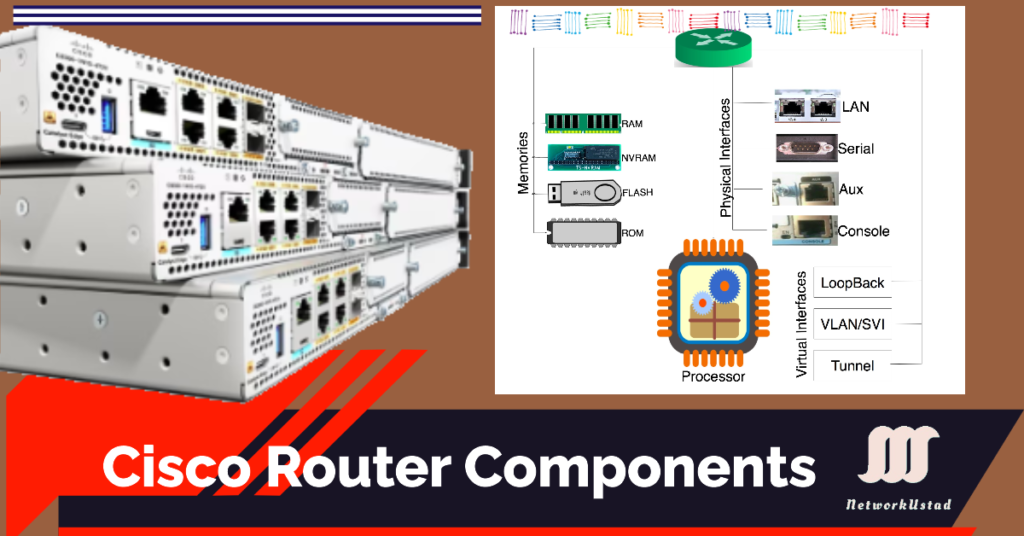Cisco Router Components Explained: Hardware, Software, and Modern Innovations (2025 Update)
Cisco routers are the backbone of modern networks, but their internal components and evolving technologies are often misunderstood. While most guides cover basic hardware like RAM and CPU, they miss critical advancements like UADP ASICs, cloud-managed routers, and SD-WAN integration. In this updated 2025 guide, we’ll explore Cisco router hardware, software, and modern innovations—complete with troubleshooting tips, CLI examples, and real-world use cases.
Introduction: Why Understanding Router Components Matters
Whether you’re troubleshooting a boot failure or designing a scalable SD-WAN, knowing your router’s internals is essential. Modern Cisco routers are no longer just “boxes with ports”—they integrate specialized hardware like ASICs and cloud-based management for unprecedented performance. Let’s break down Router components, old and new.
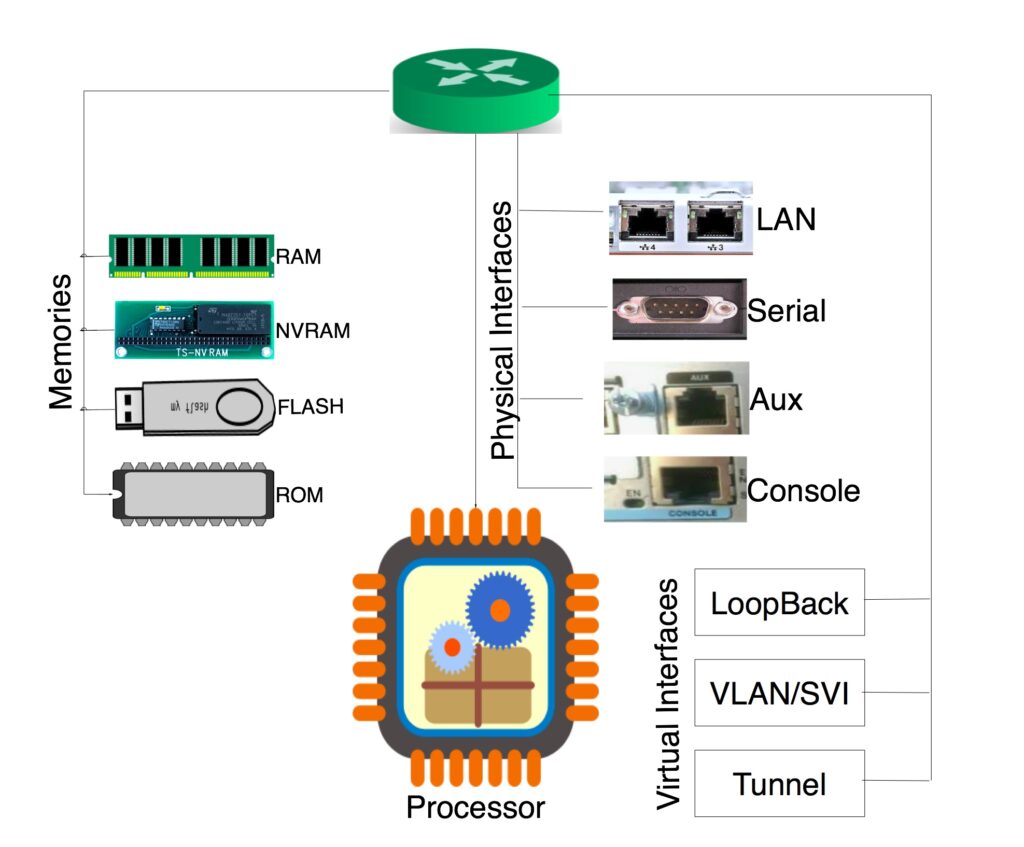
Cisco Router Components – Core Hardware
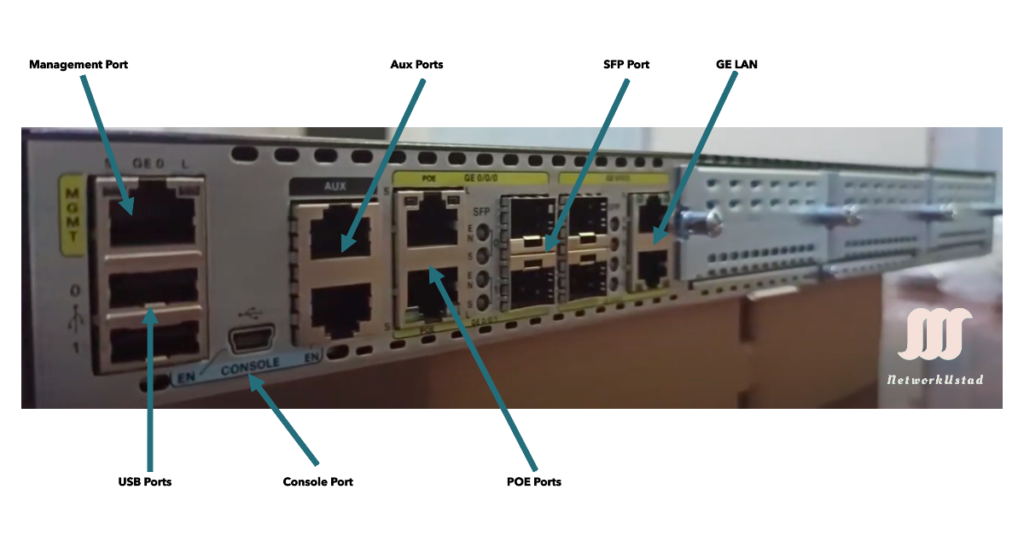
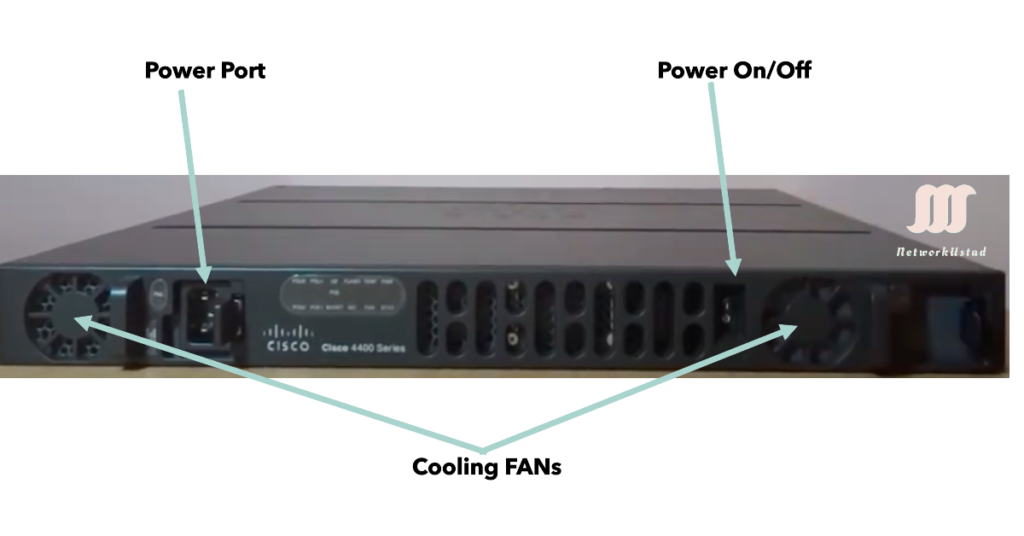
Central Processing Unit (CPU)
- Like computers, tablets, gaming consoles, and smart devices, Cisco devices need a CPU to execute OS instructions, such as system initialization, routing, and switching functions. The central processing unit (CPU) is the hardware carrying out the OS instructions for routing and switching. The CPU is sometimes called the processor for short. The CPU generates interrupts (IRQ) to communicate with other electronic components in the router.
- Executes Cisco IOS/IOS-XE commands and manages routing protocols (e.g., OSPF, BGP).
- Older routers (e.g., Cisco 2800 Series) rely heavily on the CPU, causing bottlenecks. Modern routers offload tasks to ASICs.
Memory Types
RAM (Random Access Memory)
This storage device stores the running configuration and routing tables. It is volatile, and it loses data on reboot. The RAM, or Random Access Memory, allows the router to load the IOS and the configuration file. Cisco routers use a fast type of RAM called synchronous dynamic random access memory (SDRAM). As we know, it is a volatile memory that requires power to keep the data accessible. If the router is turned off, all data in RAM is lost, and has offered the following primary function:
- Store routing table.
- Running IOS.
- Store ARP Table
- Packet buffer
- Store running configuration file.
The amount of RAM your router requires depends on the size of the IOS image and configuration file. The smaller routers (up to the 1600 series) likely work with 12 to 16 MB, while the bigger routers with larger IOS images would require around 32 to 64 MB of memory. Routing tables also run from the system’s RAM, so the router requires more RAM for larger and more complex routing tables.
The RAM size in the latest Cisco routers varies significantly depending on the router series, use case (enterprise, service provider, edge), and configuration requirements. It ranges from 16GB to 512GB depending on the model and usage.
NVRAM (Non-Volatile RAM)
Stores the startup configuration (startup-config). Survives reboots. This is non-volatile RAM (NVRAM). The NVRAM is where the router stores its configuration. It is the router’s permanent memory storage. When you configure a router and then save the configuration, it is stored in the NVRAM.
This memory is not significant compared to the system’s RAM. On old Cisco routers like the 1600 series, the size of NVRAM is only 8 KB, the 2600 series is 32 KB, and the 2900 and 3900 series have a memory of 256 KB. Usually, when a router starts up after it loads the IOS image, it will look into the NVRAM and load the configuration file to configure the router. The NVRAM is not erased when the router is reloaded or switched off.
The NVRAM size in the latest Cisco routers varies by model and series, with modern devices often using integrated or emulated storage solutions. Here’s a breakdown for the latest Cisco Routers.
- ISR 4000 Series (e.g., 4431-X): These routers typically feature 2 MB of NVRAM, which stores the startup configuration and critical system parameters. This is a common size for mid-range enterprise routers.
- Catalyst 8000 Series (Edge Platforms): These routers, designed for SD-WAN and cloud-edge deployments, often use emulated NVRAM within their flash storage. While not a dedicated chip, the adequate NVRAM capacity is tied to available flash memory, allowing for larger configurations (often up to 8 MB or more).
- ASR 9000/ASR 1000 Series (Aggregation Routers): High-end routers like the ASR 1000 may have 4–8 MB of dedicated NVRAM, though some configurations leverage flash partitions for scalability.
NVRAM Key Notes
- Emulated NVRAM: Many newer Cisco devices (running IOS XE or IOS XR) use a portion of flash memory for NVRAM functions, offering flexibility and larger effective sizes.
- CLI Check: Use
show versionto view NVRAM size on a specific device (e.g.,NVRAM: 2097152 KBindicates 2 MB). - Configuration Limits: Modern routers support larger startup-config files (up to several MB), reflecting increased NVRAM capacity compared to legacy models (256–512 KB).
Flash Memory
Flash memory is non-volatile and permanent storage for the IOS and other systems-related files such as log files, voice configuration files, HTML files, backup configurations, and much more. It holds the Cisco IOS/IOS-XE image and is upgradeable via USB or TFTP. The IOS was copied from Flash to RAM during the router reboot. RAM is an EEPROM (Electrical Erasable Programmable Read Only Memory) card. It usually fits into a particular slot at the back of the router and has nothing more than the IOS image.
The Flash memory size in Cisco routers varies widely depending on the series and use case, ranging from a few gigabytes in entry-level models to terabytes in high-end modular systems.
ROM (Read-Only Memory)
Stores bootstrap code and POST diagnostics. The ROM is used to start and keep up the router. It is a volatile memory containing some code, like Bootstrap and POST. The codes help the router do basic tests and boot up when powered on or reloaded. It has included firmware software on the integrated circuit inside the router, which can only alter Cisco. We cannot modify any code in this memory. It must be set from the factory and is Read Only. ROM stores the following:
- Limited the IOS to give a backup version of the IOS. When full-featured IOS has been deleted or corrupted, the limited IOS restores full-featured IOS.
- Boot up information that provides the startup information.
- Power-on self-test (POST)
ASICs (Application-Specific Integrated Circuits)
UADP (Unified Access Data Plane): Cisco’s custom ASIC for high-speed packet processing.
- Offloads tasks like QoS, encryption, and NAT from the CPU.
- Used in Catalyst 9000 switches and ISR 1000/4000 routers
Benefits:
- 10x faster throughput compared to CPU-only processing.
- Enables SD-WAN features like real-time traffic steering.
Interfaces and Modularity
- Fixed vs. Modular Routers
- Fixed (e.g., Cisco ISR 1000 Series): These have built-in ports (LAN, WAN), making them ideal for small offices.
- Modular (e.g., Cisco Catalyst 9500): This type supports add-on modules (e.g., 40Gbps uplinks, and wireless controllers).
Comparison Table:
| Feature | Fixed Router | Modular Router |
|---|---|---|
| Scalability | Limited | High (up to 100Gbps) |
| Cost | Lower | Higher |
| Use Case | Branch offices | Data centers, SD-WAN |
Cisco Router Interfaces
| Interface Type | Example | Use Case |
|---|---|---|
| GigabitEthernet | GigabitEthernet0/0 | LAN/WAN connectivity |
| Serial | Serial0/0/0 | Legacy WAN links |
| Loopback | Loopback0 | Routing protocols, management |
| VLAN (SVI) | Vlan10 | Inter-VLAN routing |
| Console | Console0 | Initial configuration |
| Tunnel | Tunnel0 | VPNs (GRE/IPsec) |
| SFP+ | TenGigabitEthernet0/0 | High-speed fiber uplinks |
Cisco Router Software Components
Cisco IOS/IOS-XE Operating System
Cisco IOS (Internetwork Operating System) and IOS XE are the core operating systems powering Cisco routers and switches. While IOS is the legacy monolithic OS, IOS XE is its modern, modular successor designed for scalability, programmability, and cloud integration.
IOS Feature Sets
- IP Base: Basic routing (RIP, EIGRP).
- Security: Adds VPN, firewall, and IPSec.
- Universal Image (e.g., ISR 1000 Series): Licenses unlock features on-demand.
Boot Process
- Step-by-Step Flow:
- POST: ROM checks hardware.
- Bootstrap: Loads IOS from Flash.
- IOS Initialization: Applies
startup-configfrom NVRAM.
ROM → Bootstrap → IOS Image (Flash) → startup-config (NVRAM) → running-config (RAM)
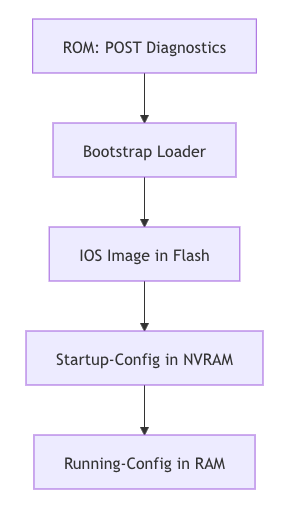
Configuration Register and Recovery
The configuration register in Cisco devices is a 16-bit value (hexadecimal) that controls critical boot behavior, such as how the device loads the IOS image, ignores the startup configuration, or enters recovery modes. Understanding it is essential for tasks like password recovery or troubleshooting boot issues.
- Default Value:
0x2102(most Cisco routers/switches). - Purpose:
- Determines boot source (flash, TFTP, ROM).
- Controls password recovery (ignoring startup-config).
- Enables ROM monitor (ROMMON) mode.
- View Current Value:
show version | include Configuration Register # Example output: Configuration register is 0x2102
Common Configuration Register Values
| Value | Behavior |
|---|---|
| 0x2102 | Normal boot (load IOS from flash, use startup-config from NVRAM). |
| 0x2142 | Ignore startup-config (used for password recovery). |
| 0x2120 | Boot from ROM (for minimal IOS or recovery). |
| 0x2100 | Boot directly into ROMMON mode. |
| 0x2101 | Boot from ROM and check for new IOS images. |
Modern Innovations in Cisco Routers
SD-WAN and Cloud-Managed Routers
- Cisco Catalyst 8000V: A virtual router for AWS/Azure.
- Managed via vManage for centralized SD-WAN policies.
- Benefits:
- Zero-touch provisioning for remote branches.
- AI-driven analytics for traffic optimization.
Case Study: A healthcare provider reduced latency by 40% using Catalyst 8000V’s cloud-based QoS policies.
IOS-XE and Application Hosting
- IOS-XE: Linux-based OS for Catalyst routers.
- Supports Docker containers for third-party apps (e.g., monitoring tools).
- Example: Host a Python script on the router to automate backups.
Troubleshooting Common Hardware/Software Issues
Boot Failures
- Symptoms: Router stuck in ROMmon mode.
- Causes: Corrupt IOS image, faulty Flash memory.
- Solutions:
- Check Flash:
dir flash: - Reload IOS:
boot flash:c2900-universalk9-mz.SPA.159-3.M12.bin
- Check Flash:
NVRAM/Flash Corruption
- Symptoms: Lost
startup-config, router resets to defaults. - Fix: Restore from backup:
Router# copy tftp://192.168.1.5/backup-config startup-config
ASIC Performance Issues
- Symptoms: High CPU despite low traffic.
- Diagnosis: Verify ASIC offloading with
show platform hardware throughput. - Fix: Enable hardware acceleration:
Router(config)# interface GigabitEthernet0/1
Router(config-if)# ip nat inside source list 1 pool NAT_POOL hardware-count
Conclusion
Cisco routers have evolved from basic packet forwarders to AI-driven, cloud-managed powerhouses. By mastering their hardware (CPU, ASICs), software (IOS-XE), and modern innovations (SD-WAN), you can optimize performance and troubleshoot like a pro. Don’t let outdated guides hold you back—leverage UADP ASICs and Catalyst 8000V to future-proof your network.
FAQs
-
NVRAM (Non-Volatile RAM) stores the startup configuration file (
startup-config). It retains data even when the router is powered off.
